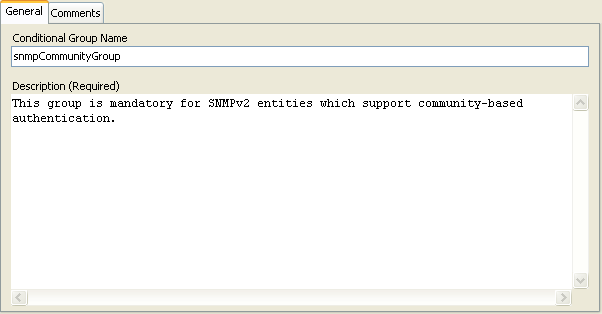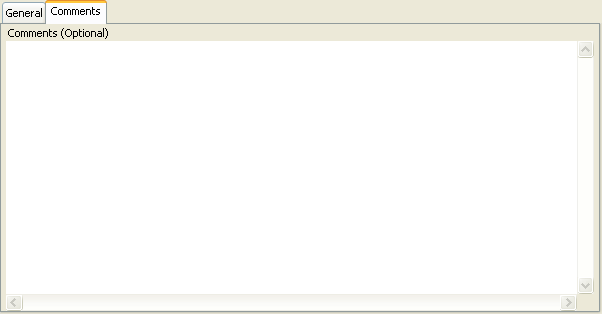MIB Smithy
Conditional Groups
Conditional Group records are a part of MODULE-COMPLIANCE statements; more specifically, they are defined within Conformance Modules. They are used to add references to OBJECT-GROUPs and NOTIFICATION-GROUPs, called out by the macro's GROUP clause. This clause is similar in function to the Mandatory Groups in function except that it allows the compliance statement to add a description providing the reader or implementor information under which the group is optional or mandatory.
Further, if the MODULE-COMPLIANCE statement is to list any OBJECT (variation) clauses, then each object referenced must be a member of a group referenced by a GROUP clause or the MANDATORY-GROUPs statement.
Creating a Conditional Group
Since the names for this record type are not automatically assigned by MIB Smithy, and since they are not normal self-contained records but instead part of a MODULE-COMPLIANCE record (specifically, part of the MODULE clause), Conditional Groups can only be created through the Conformance Module Workspace . See the Conditional Groups property for details.
General Properties
The Conditional Group Name and Description properties are both available to be edited from the General Page of the Conditional Group Workspace, which is pictured below.

Figure - Conditional Group Workspace, General Page
Conditional Group Name
The Conditional Group's Name property is the first item of the GROUP clause of the MODULE-COMPLIANCE statement. It is normally used to reference an existing OBJECT-GROUP or NOTIFICATION-GROUP record in order to state the terms under which the group must be implemented for compliance. If the module referenced by the parent MODULE clause is an SMIv1 module, this property may reference any record naming an OID value (i.e., an ASN.1 Value Assignment of type OBJECT IDENTIFIER). In such a case, any OBJECT-TYPE within the named tree that has a STATUS value of mandatory is considered to be a member of the group.
A valid group name begins with a lowercase letter and may contain zero or more additional letters or numbers. Hyphens are allowed provided the name does not end in a hyphen and no two hyphens are adjacent.
This property is unconditionally required.
Description
The Conditional Group's Description property is used to document to the reader or implementor the conditions under which the group is optional or required in order to claim conformance to the MODULE-COMPLIANCE statement.
This property is unconditionally required.
See Also
Comments Property
The Comments Property, which is common to all MIB Smithy records for which ASN.1 is generated (including modules, type assignments, Conformance Modules, etc.), allows you to specify optional comments that are to be associated with the record. Like comments in programming languages, ASN.1 comments are bits of text that allow extra descriptive text to be provided that are discarded by normal parsers. When MIB Smithy generates the module, either when saving or previewing, the comments for a particular record will be generated immediately above the record they are associated with.
See Also

Figure - Conformance Group Workspace, Comments Page
